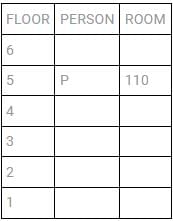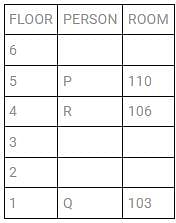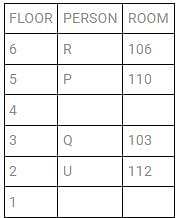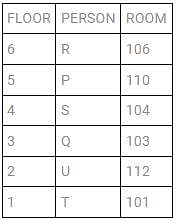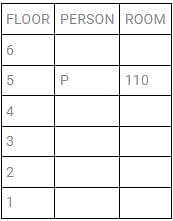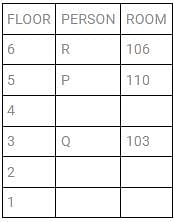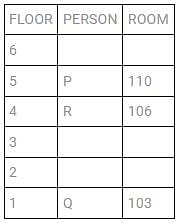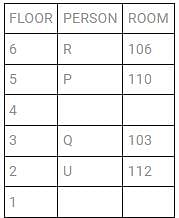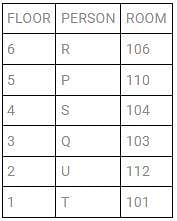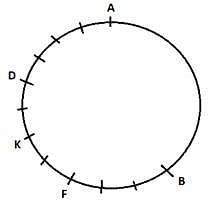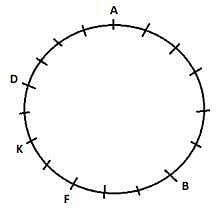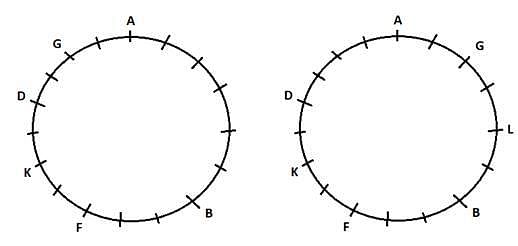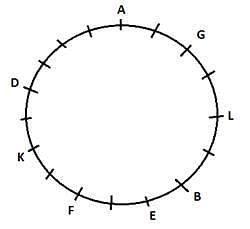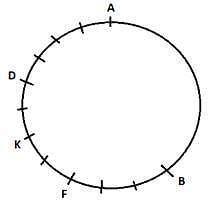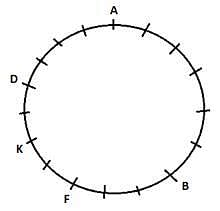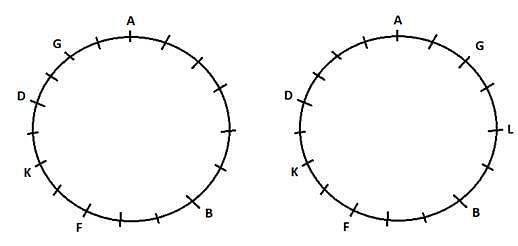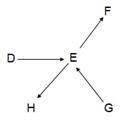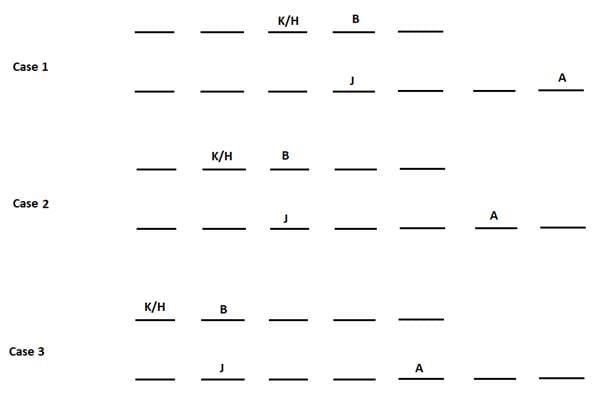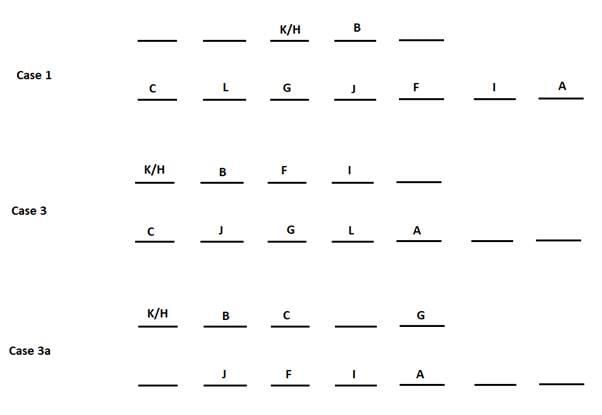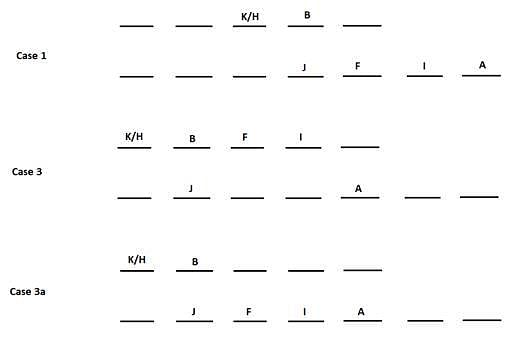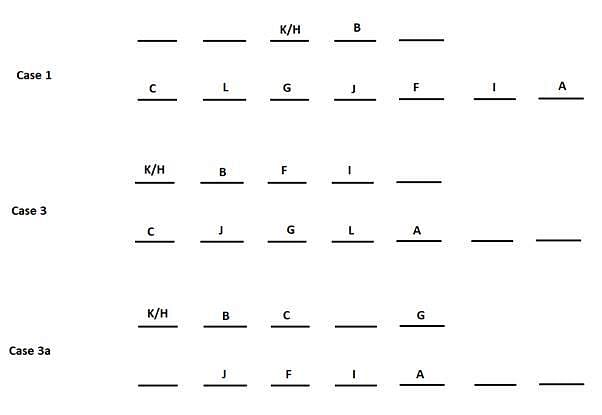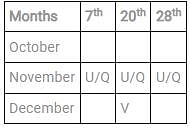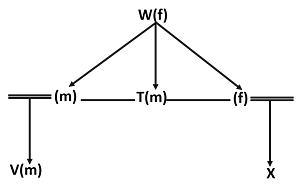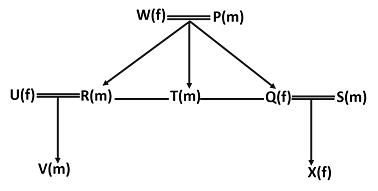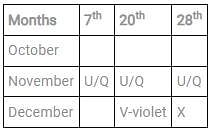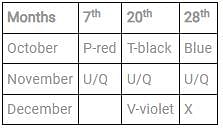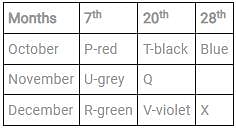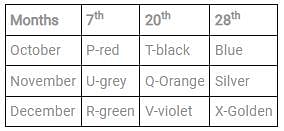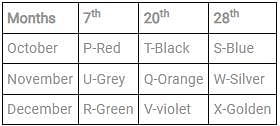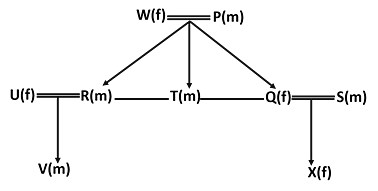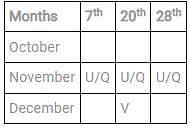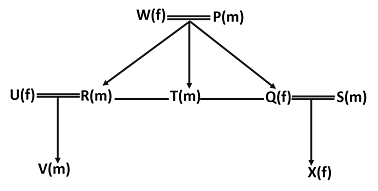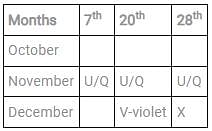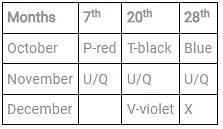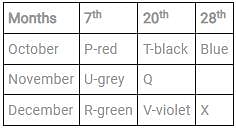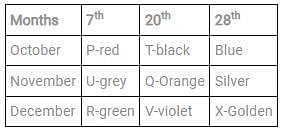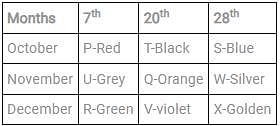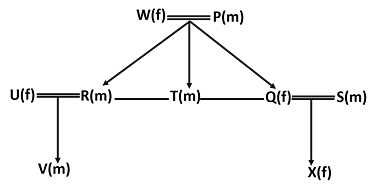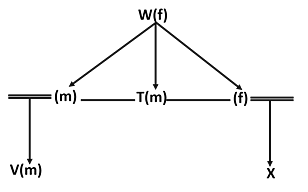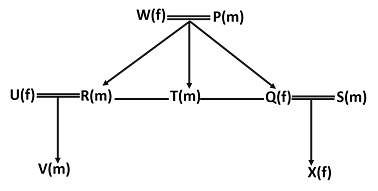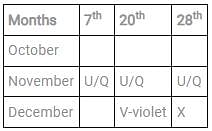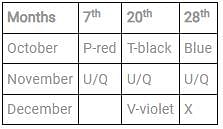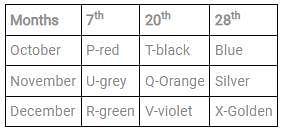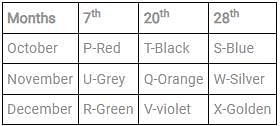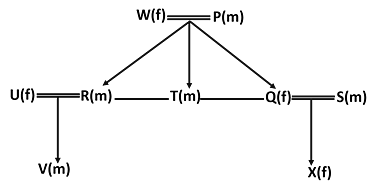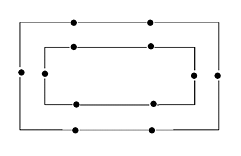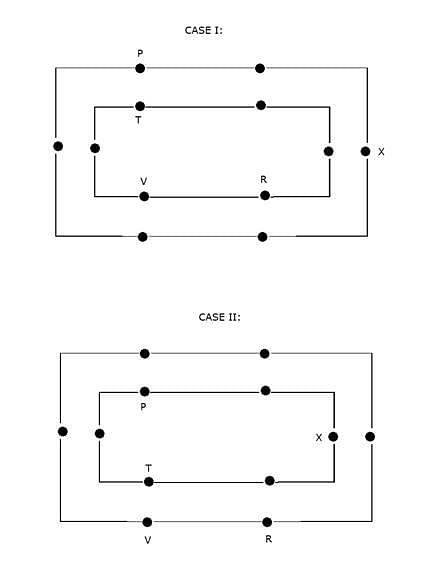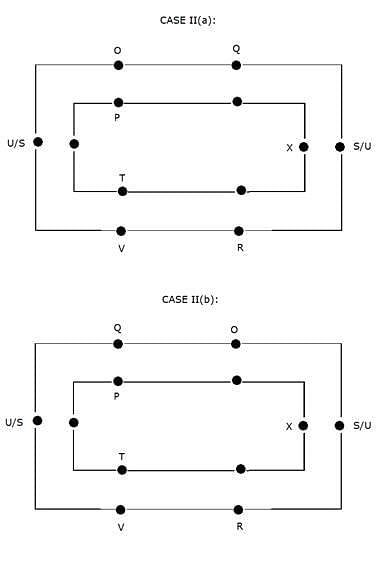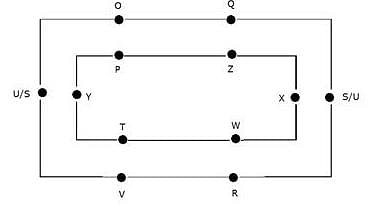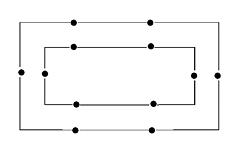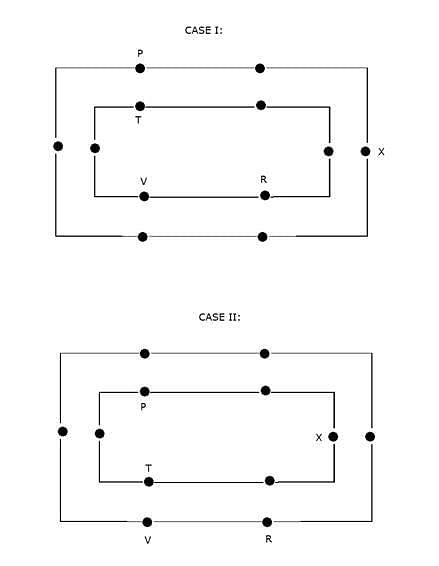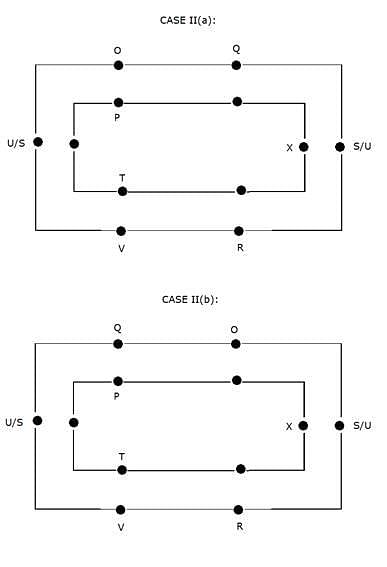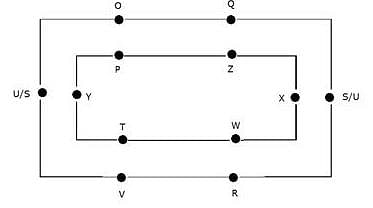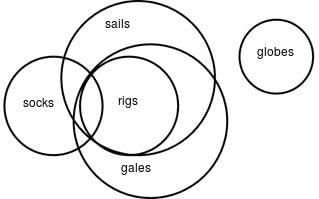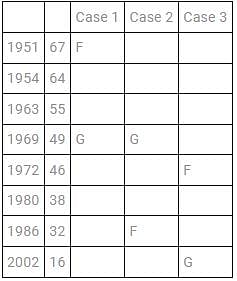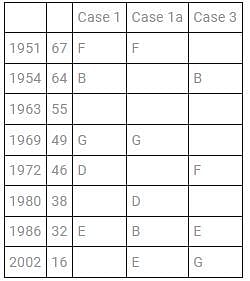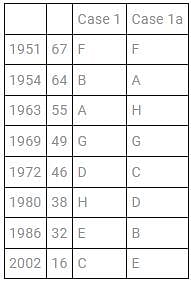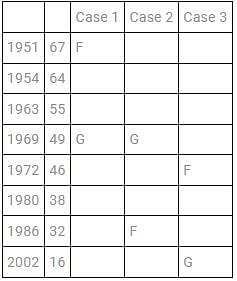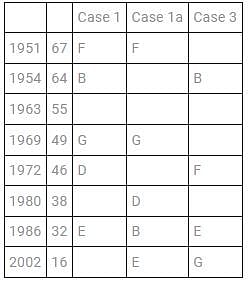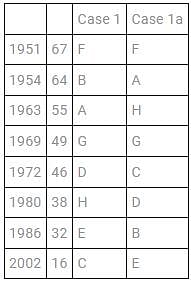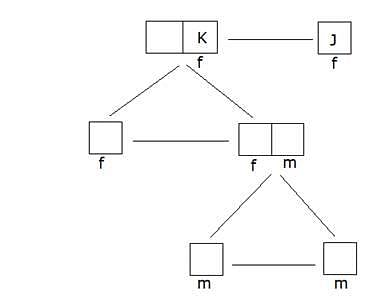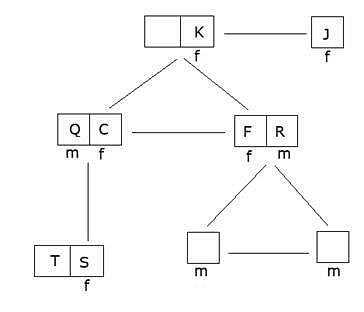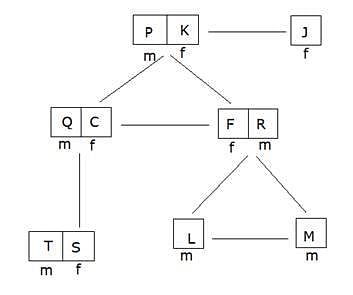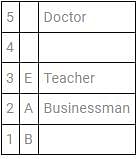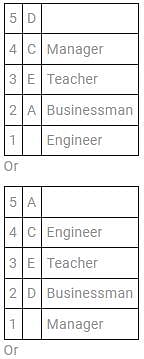EPFO Assistant Mains Mock Test - 2 - Bank Exams MCQ
30 Questions MCQ Test Mock Test Series for EPFO Assistant 2025 - EPFO Assistant Mains Mock Test - 2
Directions [Set of 4 Questions]: Six people P,Q,R,S,T,U were living in a six floored apartment numbered from 1-6 ( 6 being the topmost floor). Only one person was living on each floor. Each of them was of different age and the room number in which they lived was different for everyone. The people in decreasing order of their age are:
R(106)>Q(103)>S(104)>U(112)>P(110)>T(101)
(Note:- R(106) means that the room number of R is 106.)
Further it is known that two people lived between the person with third highest room number and the person who was second eldest where the former lived above the latter. The person whose room number was second least, lived just above the person who was third youngest. The person who was second youngest lived on the 5th floor. The person living just below U, lived on an odd numbered room.
Q. The person living in room 104 lived on which floor?
R(106)>Q(103)>S(104)>U(112)>P(110)>T(101)
(Note:- R(106) means that the room number of R is 106.)
Further it is known that two people lived between the person with third highest room number and the person who was second eldest where the former lived above the latter. The person whose room number was second least, lived just above the person who was third youngest. The person who was second youngest lived on the 5th floor. The person living just below U, lived on an odd numbered room.
Directions [Set of 4 Questions]: Six people P,Q,R,S,T,U were living in a six floored apartment numbered from 1-6 ( 6 being the topmost floor). Only one person was living on each floor. Each of them was of different age and the room number in which they lived was different for everyone. The people in decreasing order of their age are:
R(106)>Q(103)>S(104)>U(112)>P(110)>T(101)
(Note:- R(106) means that the room number of R is 106.)
Further it is known that two people lived between the person with third highest room number and the person who was second eldest where the former lived above the latter. The person whose room number was second least, lived just above the person who was third youngest. The person who was second youngest lived on the 5th floor. The person living just below U, lived on an odd numbered room.
Q. What is the difference in the room number of the person living on 3rd floor and 6th floor?
R(106)>Q(103)>S(104)>U(112)>P(110)>T(101)
(Note:- R(106) means that the room number of R is 106.)
Further it is known that two people lived between the person with third highest room number and the person who was second eldest where the former lived above the latter. The person whose room number was second least, lived just above the person who was third youngest. The person who was second youngest lived on the 5th floor. The person living just below U, lived on an odd numbered room.
| 1 Crore+ students have signed up on EduRev. Have you? Download the App |
Directions [Set of 4 questions]: Eight persons A, B, D, E, F, G, K and L were seated around a circular table facing the centre. There were 'n' number of chairs around the table of which few were vacant, and the rest were taken by these 8 persons
- A was on a chair that was 4th to the left of D who was on a chair that was 2nd to the left of K
- G was on a chair that was 2nd to the right of L and was seated at a gap of 1 seat from A
- There were only 2 seats between L and E when counted from the right of E
- B was on a chair that was 3rd to the right of F, who was seated at a gap of 1 seat from K
- There were 8 seats between A and F when counted from the left of A
Q. __________ and __________ were neighbouring each other
Directions [Set of 4 questions]: Eight persons A, B, D, E, F, G, K and L were seated around a circular table facing the centre. There were 'n' number of chairs around the table of which few were vacant, and the rest were taken by these 8 persons
- A was on a chair that was 4th to the left of D who was on a chair that was 2nd to the left of K
- G was on a chair that was 2nd to the right of L and was seated at a gap of 1 seat from A
- There were only 2 seats between L and E when counted from the right of E
- B was on a chair that was 3rd to the right of F, who was seated at a gap of 1 seat from K
- There were 8 seats between A and F when counted from the left of A
Q. How many persons were seated between K and L when counted from the right of K?
Question given below consists of a question and two statements numbered I and II given below it. You have to decide whether the data provided in the statements are sufficient to answer the question:
Six friends P, Q, R, S, T and U are sitting in a row facing towards south and each one belongs to different profession says CA, MR, Doctor, PO, Clerk and HR then who sits immediate left of Doctor?
I. R sits third to the right of PO, who sits second to the left of MR. HR sits third to the right of S, who sits second to the right of Clerk. P sits second to the right of Q, who sits third to the right of T.
II. P sits second to the right of MR, who sits second to the right of U and Q sits third to the right of clerk. T sits second to the left of S, who sits second to the left of CA and R sits third to the right of PO, who sits immediate right of T.
Consider the following and answer accordingly:
- 'A * B' means 'A is to the north-east of B'
- 'A @ B' means 'A is to the south of B'
- 'A # B' means 'A is to the south-west of B'
- 'A % B' means 'A is to the east of B'
- 'A $ B' means 'A is to the north-west of B'
Q. What is the direction of D with respect to G in the expression 'F*E%D, H#E$G'?
Directions [Set of 3 questions]: Consider the following:
- 'A@B' means 'A is neither smaller nor equal to B'
- 'A&B' means 'A is neither greater nor equal to B'
- 'A^B' means 'A is not smaller than B'
- 'A#B' means 'A is neither smaller nor greater than B'
- 'A$B' means 'A is not greater than B'
Now in each of the following questions, assuming the given statements to be true, find which of the two conclusions given below them is/are true.
Statement:
J&H, J^M, J$Q, U@J
Conclusion:
I. M&H
II. H@U
Directions [Set of 5 questions]: A word and number arrangement machine when given an input line of words and numbers rearranges them following a particular rule in each step. The following is an illustration of an input and rearrangement.
- Input: 42 19 20 57 12 31 Gate Apply Juke Little Kick Pineapple
- Step I: 57 42 19 20 12 31 Gate Juke Little Kick Pineapple Apply
- Step II: 57 12 42 19 20 31 Juke Little Kick Pineapple Apply Gate
- Step III: 57 12 31 42 19 20 Little Kick Pineapple Apply Gate Juke
- Step IV: 57 12 31 20 42 19 Little Pineapple Apply Gate Juke Kick
- Step V: 57 12 31 20 19 42 Pineapple Apply Gate Juke Kick Little
- Step VI: 57 12 31 20 19 42 Apply Gate Juke Kick Little Pineapple
And Step VI is the final step of the output
As per the rules followed in the above steps, find out in each of the following questions the appropriate step for the given input.
Input: 21 56 36 53 69 63 48 Kate Balloon Fit Tight Month Opposite Six
Q. How many steps are required for the given input?
Directions [Set of 5 questions]: A word and number arrangement machine when given an input line of words and numbers rearranges them following a particular rule in each step. The following is an illustration of an input and rearrangement.
- Input: 42 19 20 57 12 31 Gate Apply Juke Little Kick Pineapple
- Step I: 57 42 19 20 12 31 Gate Juke Little Kick Pineapple Apply
- Step II: 57 12 42 19 20 31 Juke Little Kick Pineapple Apply Gate
- Step III: 57 12 31 42 19 20 Little Kick Pineapple Apply Gate Juke
- Step IV: 57 12 31 20 42 19 Little Pineapple Apply Gate Juke Kick
- Step V: 57 12 31 20 19 42 Pineapple Apply Gate Juke Kick Little
- Step VI: 57 12 31 20 19 42 Apply Gate Juke Kick Little Pineapple
And Step VI is the final step of the output
As per the rules followed in the above steps, find out in each of the following questions the appropriate step for the given input.
Input: 21 56 36 53 69 63 48 Kate Balloon Fit Tight Month Opposite Six
Q. Which of the following is sixth from the left in step VI?
Directions [Set of 5 questions]: A word and number arrangement machine when given an input line of words and numbers rearranges them following a particular rule in each step. The following is an illustration of an input and rearrangement.
- Input: 42 19 20 57 12 31 Gate Apply Juke Little Kick Pineapple
- Step I: 57 42 19 20 12 31 Gate Juke Little Kick Pineapple Apply
- Step II: 57 12 42 19 20 31 Juke Little Kick Pineapple Apply Gate
- Step III: 57 12 31 42 19 20 Little Kick Pineapple Apply Gate Juke
- Step IV: 57 12 31 20 42 19 Little Pineapple Apply Gate Juke Kick
- Step V: 57 12 31 20 19 42 Pineapple Apply Gate Juke Kick Little
- Step VI: 57 12 31 20 19 42 Apply Gate Juke Kick Little Pineapple
And Step VI is the final step of the output
As per the rules followed in the above steps, find out in each of the following questions the appropriate step for the given input.
Input: 21 56 36 53 69 63 48 Kate Balloon Fit Tight Month Opposite Six
Q. Which of the following is 3rd from the right in Step III?
Directions [Set of 3 questions]: Consider the following data:

Each element is denoted by a symbol as shown above. Further, consider the given conditions and answer accordingly.
- If the third element is even and fifth element is odd, then the code for both the elements should be interchanged.
- If the first element is consonant and fifth element is vowel, then the code for both the elements should be coded as '@'.
- If the third element is even and sixth element is consonant, then the code for third element should be the code for sixth element.
Q. A42CRZ
Directions [Set of 3 questions]: Consider the following data:

Each element is denoted by a symbol as shown above. Further, consider the given conditions and answer accordingly.
- If the third element is even and fifth element is odd, then the code for both the elements should be interchanged.
- If the first element is consonant and fifth element is vowel, then the code for both the elements should be coded as '@'.
- If the third element is even and sixth element is consonant, then the code for third element should be the code for sixth element.
Q. R34CO6
Directions [Set of 5 questions]: Twelve persons A, B, C, D, E, F, G, H, I, J, K and L were seated in two rows such that five of them were in row 1 and the rest were seated in row 2. The 2 rows started at an equal gap from the western side wall, thus, the five seats in row 1 were exactly in line with the first five seats of row 2. They were seated facing the North.
F was seated 3rd from one of the corners. I was to the immediate right of F. A was seated 3rd to the right of J who was seated exactly behind B. B was to the immediate right of either K or H. C was 2nd to the left of G. Number of persons seated to the left of L was same as the number of persons to the right of B and they were seated in different rows. The person seated exactly behind D was 2nd to the left of E. Number of persons seated to the left of J was equal to the number of persons to the right of H.
Q. Who among the following was seated 3rd to the left of H?
Directions [Set of 5 questions]: Twelve persons A, B, C, D, E, F, G, H, I, J, K and L were seated in two rows such that five of them were in row 1 and the rest were seated in row 2. The 2 rows started at an equal gap from the western side wall, thus, the five seats in row 1 were exactly in line with the first five seats of row 2. They were seated facing the North.
F was seated 3rd from one of the corners. I was to the immediate right of F. A was seated 3rd to the right of J who was seated exactly behind B. B was to the immediate right of either K or H. C was 2nd to the left of G. Number of persons seated to the left of L was same as the number of persons to the right of B and they were seated in different rows. The person seated exactly behind D was 2nd to the left of E. Number of persons seated to the left of J was equal to the number of persons to the right of H.
Q. Who was seated exactly in front of L?
Directions [Set of 5 questions]: A family of nine members P, Q, R, S, T, U, V, W and X has each member attending their respective friend's wedding in the month of October, November and December. These weddings take place on 7th, 20th and 28th of above mentioned month. only one family member visits one wedding and only one wedding takes place on any given date. Also, family members are wearing dresses of different colours for wedding ceremonies.
The one wearing red dress and first to visit wedding is eldest male member of the family. V visits wedding on an even numbered date but not in a month with even number of days. The person who visits last is the youngest female member of family. U and Q visits wedding in same month but not in October or in the same month as V. Persons wearing black and blue dress visit wedding in same month. W is grandmother of X and the one wearing a violet dress for wedding. P, a male member, has an unmarried son who wears black for wedding and visits wedding immediately after P. R is wearing green colour dress and his wife is wearing a grey colour dress, both attend wedding on same dates of different months. Orange coloured dress is worn on an even date immediately before silver coloured dress worn in same month. V is a male member. T is the maternal uncle of X and paternal uncle of V. U is spouse of one of the children of P. S is the son-in-law of W and is not married to U. W is not wearing grey dress. One of the family member wear golden dress and W visits the wedding after the same date of that of S, who has a daughter.
Answer the following questions based on the above information:
Q. Who is wearing blue coloured dress?
Directions [Set of 5 questions]: A family of nine members P, Q, R, S, T, U, V, W and X has each member attending their respective friend's wedding in the month of October, November and December. These weddings take place on 7th, 20th and 28th of above mentioned month. only one family member visits one wedding and only one wedding takes place on any given date. Also, family members are wearing dresses of different colours for wedding ceremonies.
The one wearing red dress and first to visit wedding is eldest male member of the family. V visits wedding on an even numbered date but not in a month with even number of days. The person who visits last is the youngest female member of family. U and Q visits wedding in same month but not in October or in the same month as V. Persons wearing black and blue dress visit wedding in same month. W is grandmother of X and the one wearing a violet dress for wedding. P, a male member, has an unmarried son who wears black for wedding and visits wedding immediately after P. R is wearing green colour dress and his wife is wearing a grey colour dress, both attend wedding on same dates of different months. Orange coloured dress is worn on an even date immediately before silver coloured dress worn in same month. V is a male member. T is the maternal uncle of X and paternal uncle of V. U is spouse of one of the children of P. S is the son-in-law of W and is not married to U. W is not wearing grey dress. One of the family member wear golden dress and W visits the wedding after the same date of that of S, who has a daughter.
Answer the following questions based on the above information:
Q. Who is visiting wedding on 28th November?
Directions [Set of 5 questions]: A family of nine members P, Q, R, S, T, U, V, W and X has each member attending their respective friend's wedding in the month of October, November and December. These weddings take place on 7th, 20th and 28th of above mentioned month. only one family member visits one wedding and only one wedding takes place on any given date. Also, family members are wearing dresses of different colours for wedding ceremonies.
The one wearing red dress and first to visit wedding is eldest male member of the family. V visits wedding on an even numbered date but not in a month with even number of days. The person who visits last is the youngest female member of family. U and Q visits wedding in same month but not in October or in the same month as V. Persons wearing black and blue dress visit wedding in same month. W is grandmother of X and the one wearing a violet dress for wedding. P, a male member, has an unmarried son who wears black for wedding and visits wedding immediately after P. R is wearing green colour dress and his wife is wearing a grey colour dress, both attend wedding on same dates of different months. Orange coloured dress is worn on an even date immediately before silver coloured dress worn in same month. V is a male member. T is the maternal uncle of X and paternal uncle of V. U is spouse of one of the children of P. S is the son-in-law of W and is not married to U. W is not wearing grey dress. One of the family member wear golden dress and W visits the wedding after the same date of that of S, who has a daughter.
Answer the following questions based on the above information:
Q. What is colour of W's dress?
Directions [Set of 4 questions]: A small rectangular slab is kept above a large rectangular slab such that their centres coincide with each other. Twelve points are marked on the edges of the slabs, six on each slab, such that, the longer sides of both the slabs have two points each, and the shorter side has one point each. Each point of one slab is in same line of sight on other slab. Also, point marked in between two points is to be considered in the same line of sight. (to the right of any point - anticlockwise, to the left of any point - clockwise)
- V is marked to immediate left of R.
- T is marked in between V and P, which is marked second to right of X.
- O and Q are marked on the longer side of same slab.
- T and X, are marked on the same slab.
- Y is not marked at any point immediately left/right of X.
- U and S are maximum possible distance apart.
- O is not marked in front of either Z or W.
- Z is not marked in front of R.
Q. Which point is marked to immediate right of R?
Directions [Set of 4 questions]: A small rectangular slab is kept above a large rectangular slab such that their centres coincide with each other. Twelve points are marked on the edges of the slabs, six on each slab, such that, the longer sides of both the slabs have two points each, and the shorter side has one point each. Each point of one slab is in same line of sight on other slab. Also, point marked in between two points is to be considered in the same line of sight. (to the right of any point - anticlockwise, to the left of any point - clockwise)
- V is marked to immediate left of R.
- T is marked in between V and P, which is marked second to right of X.
- O and Q are marked on the longer side of same slab.
- T and X, are marked on the same slab.
- Y is not marked at any point immediately left/right of X.
- U and S are maximum possible distance apart.
- O is not marked in front of either Z or W.
- Z is not marked in front of R.
Q. Find the odd pair out of the following.
In the following questions, a set of statements is followed by some conclusions, one of which definitely does not follow (or is not a possibility of occurrence). Choose that conclusion as the answer.
Statements:
Some socks are rigs
All rigs are gales
Many gales are sails
No sail is a globe.
Conclusions:
Directions[Set of 2 questions]: Mayank was going to eight different places in Rajasthan. He had a map in which he marked these eight places with codes as A,B,C,D,E,F,G,H. Each of these places had a different temperature. Further it is known that E had the second highest temperature. F had a higher temperature than G . At least two places had a higher temperature than D. Three places had temperature value between the temperature of C and H, where C was warmer. Neither F nor B had the highest temperature. B had a lower temperature than D but higher than G. C had a temperature just lower than D.
Q. How many places had temperature higher than G but lower than A?
Directions [Set of 5 questions]: Eight persons A, B, C, D, E, F, G and H were born in the years 1951, 1954, 1963, 1969, 1972, 1980, 1986 and 2002 not necessarily in the same order. They were born on the same date i.e. on 1st January of these years. Make all the age calculations as on 1st January 2018.
- G's age was found to be a perfect square
- G and F were born at a gap of 2 persons
- B was aged twice as that of E
- D was born at a gap of 1 from E
- A was elder to H who was elder to C
- At least one person was born between A and G
Q. Who among the following was born in 1986?
Directions [Set of 5 questions]: Eight persons A, B, C, D, E, F, G and H were born in the years 1951, 1954, 1963, 1969, 1972, 1980, 1986 and 2002 not necessarily in the same order. They were born on the same date i.e. on 1st January of these years. Make all the age calculations as on 1st January 2018.
- G's age was found to be a perfect square
- G and F were born at a gap of 2 persons
- B was aged twice as that of E
- D was born at a gap of 1 from E
- A was elder to H who was elder to C
- At least one person was born between A and G
Q. Who among the following was the eldest?
Six TV serials Aapka sapna, Betiya, Chatur, Dosti, Ehsaan and Farishta are telecasted at 6 pm, 6:30 pm, 7 pm, 7:30 pm, 8 pm, 8:30 pm not necessarily in the same order. Dosti is telecasted before Ehsaan and after Farishta and Betiya is telecasted before Aapka sapna and after Chatur. If Betiya is telecasted at 7 pm, number of programs between Ehsaan and Dosti is equal to the number of programs between Dosti and Farishta and Aapka sapna is not telecasted at 8:30 pm, at what time is Farishta telecasted?
Directions [Set of 3 questions]: A family has 11 members. K and J are two sisters and only one of them is married. S is niece of F, who is wife of R. K has two children who are both females and married, and one of them has two sons only. S is the only child of her parents and Q is the husband of C, who is niece of J. P is grandfather of L and M. S is married to T. (either both or none of the parents of any child is alive)
Q. How is T related to C.
Directions [Set of 3 questions]: Study the following information carefully and answer the questions given below:
In certain code language,
- "Super Fast Furious Bullet" is coded as "Arr Krr Trr Grr"
- "Bullet Train Tunnel Road" is coded as "Hrr Prr Zrr Krr"
- "Train Tunnel Highway Fast" is coded as "Hrr Arr Zrr Lrr"
- "Super Duper Road" is coded as "Trr Prr Nrr"
Q. Code of which of the following sentences is/are required to find the code for 'Train'?
I. Tunnel train Rocket
II. Train Rocket Airplane
III. Tunnel Boat Ship
Directions [Set of 3 questions]: Study the following information carefully and answer the questions given below:
In certain code language,
- "Super Fast Furious Bullet" is coded as "Arr Krr Trr Grr"
- "Bullet Train Tunnel Road" is coded as "Hrr Prr Zrr Krr"
- "Train Tunnel Highway Fast" is coded as "Hrr Arr Zrr Lrr"
- "Super Duper Road" is coded as "Trr Prr Nrr"
Q. Which of the following can be the code for "Train Highway Slide"?
A revolution shatters institutions and power relationships. Students in Berlin and New York, in Turin and Tokyo, capture their deans and chancellors, bring great clanking education factories to a grinding halt, and even threaten to topple governments.
Q. Which of the following statements best describes the relationship between the two sentences?
Each of the questions below consists of a question and 2 statements numbered I and II. You have to decide whether the data provided in the statements are sufficient to answer the question.
6 persons A, B, C, D, E and F are standing in a line, one behind another facing north. It is also known that they are standing as per their heights such that shortest person is standing at the first position and tallest person is standing at the last position in the line. Who is standing 3rd from the starting of the line?
I. A is taller than F and is standing ahead of B. C is standing ahead of D. C is taller than B but shorter than E.
II. D is the tallest person whereas F is the shortest person. E is standing is immediately ahead D. A is standing immediately behind F. Number of persons standing ahead of B are same as the number of persons standing behind C.
Five professionals A, B, C, D and E lived in a building with 5 floors. The floors were numbered 1-5 from bottom to top. Only one person lived on each floor. They had different professions viz. manager, engineer, doctor, teacher and businessman not necessarily in the same order. Who was the Teacher?
Statement 1: The Doctors floor number was 3 more than A's floor number. Only one person lived between Doctor and E. The Teacher lived on an odd valued floor. Teacher lived just above the Businessman. B lived on floor 1.
Statement 2: C's floor number was twice as that of the Businessman's floor number. Teacher lived just above the Businessman. D lived just above the manager. Engineer lived just below A. E lived on floor 3


